How To Open An Outpost In Social Media Exile
David Carroll / Nov 26, 2022Lacking options, many seek refuge on Mastodon, writes David Carroll, while others embrace change.
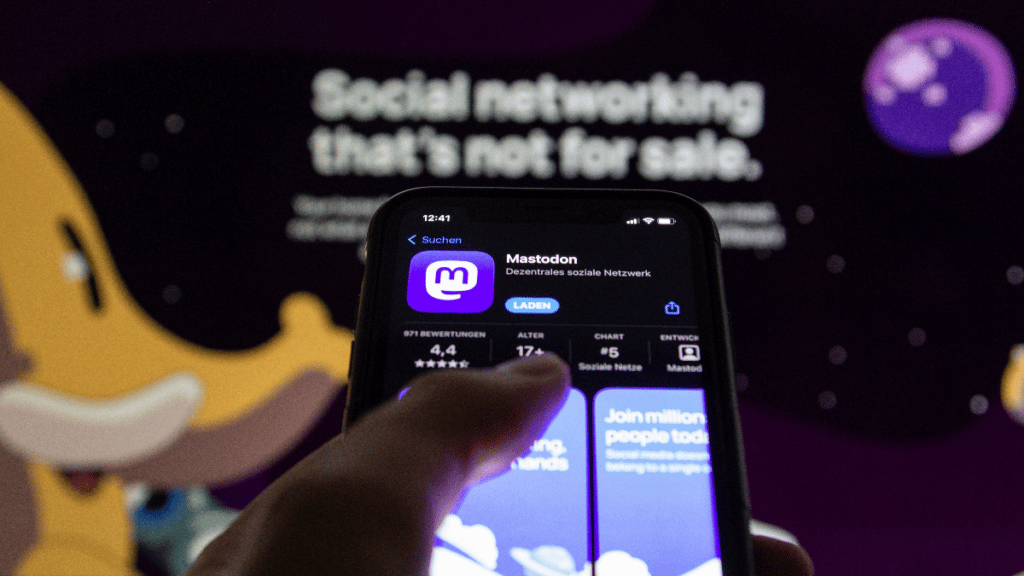
It’s de rigueur to own your own social media platform as a vanity project to amplify your own malignant narcissism these days. In the case of a certain billionaire, it seems like he bought Twitter to own the libs. Rather than being owned, a stampede ensued of academics, activists, curious journalists, and concerned citizens who rode en masse into a previously obscure alternative social media space known as the Fediverse (a parallel universe of free and open-source platforms and services built around decentralization). At one peak in the past week, tens of thousands of new Mastodon accounts were being created every hour. The active user base doubled from 1 to 2 million users in the span of a week, according to the software’s chief developer.
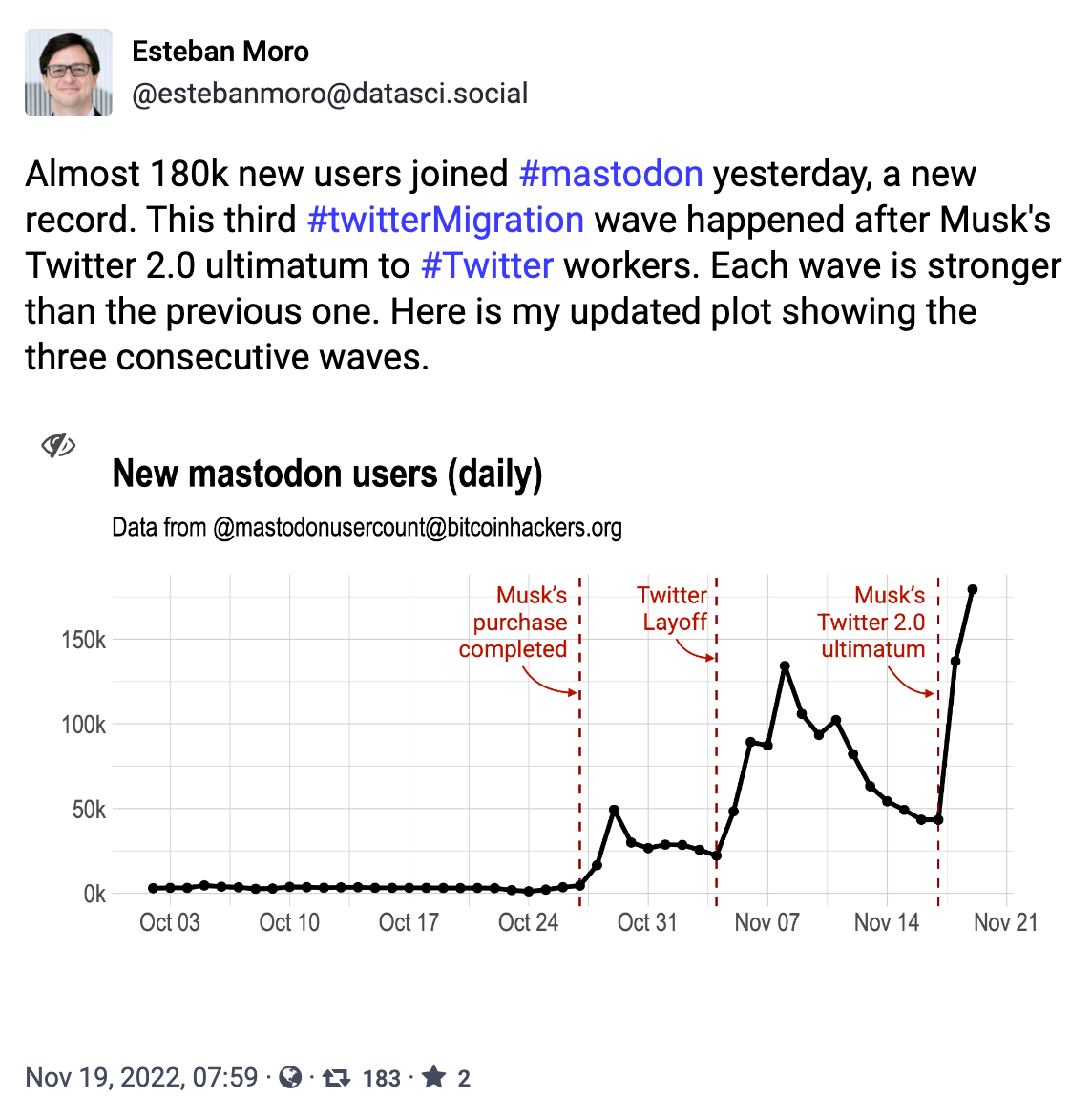
The primary software in this alternate universe — which largely replicates the experience of being on Twitter — is called Mastodon. However, Mastodon is not a replacement for Twitter. In many ways, its creators and community want to build an anti-Twitter, or at least a billionaire-proof Twitter. I created an account on the Mastodon project’s own server when it first appeared in 2016, and found it curious, if a little befuddling. I foolishly allowed myself to get worked up into a tizzy about its DM feature not being encrypted. My original account on mastodon.social, which has since become known as the Big Instance, gathered dust. Twitter’s grip on my attention seemed invincible.
Seeing the writing on the wall in the fall of 2022, the direction Elon Musk was taking Twitter clarified the cause for alarm. By granting amnesty to the most harmful voices while purposefully chasing benevolent voices away, his plan to destroy Twitter as we knew it became undeniable. He’s pivoting our once beloved doom-scrolling app to an all-out shitposting service. In response, I checked out the feeds over on the ‘fedi,’ and sure enough there was a bustle of activity. I noticed chatter about a dedicated, managed Mastodon hosting service that basically offered one-click setup. I may have been one of the last new customers to join before the operator had to suspend sign-ups to stabilize capacity and demand. Being a legacy blue-check person on the birdsite (as it’s referred to by folks on Mastodon), I was dismayed at the prospect of having to rent my own identity, and worse, be charged based on my following and reach. What if I took the $8 soon-to-be-levied by Elon Musk for subscriptions on Twitter and instead spent it on my own Mastodon server?
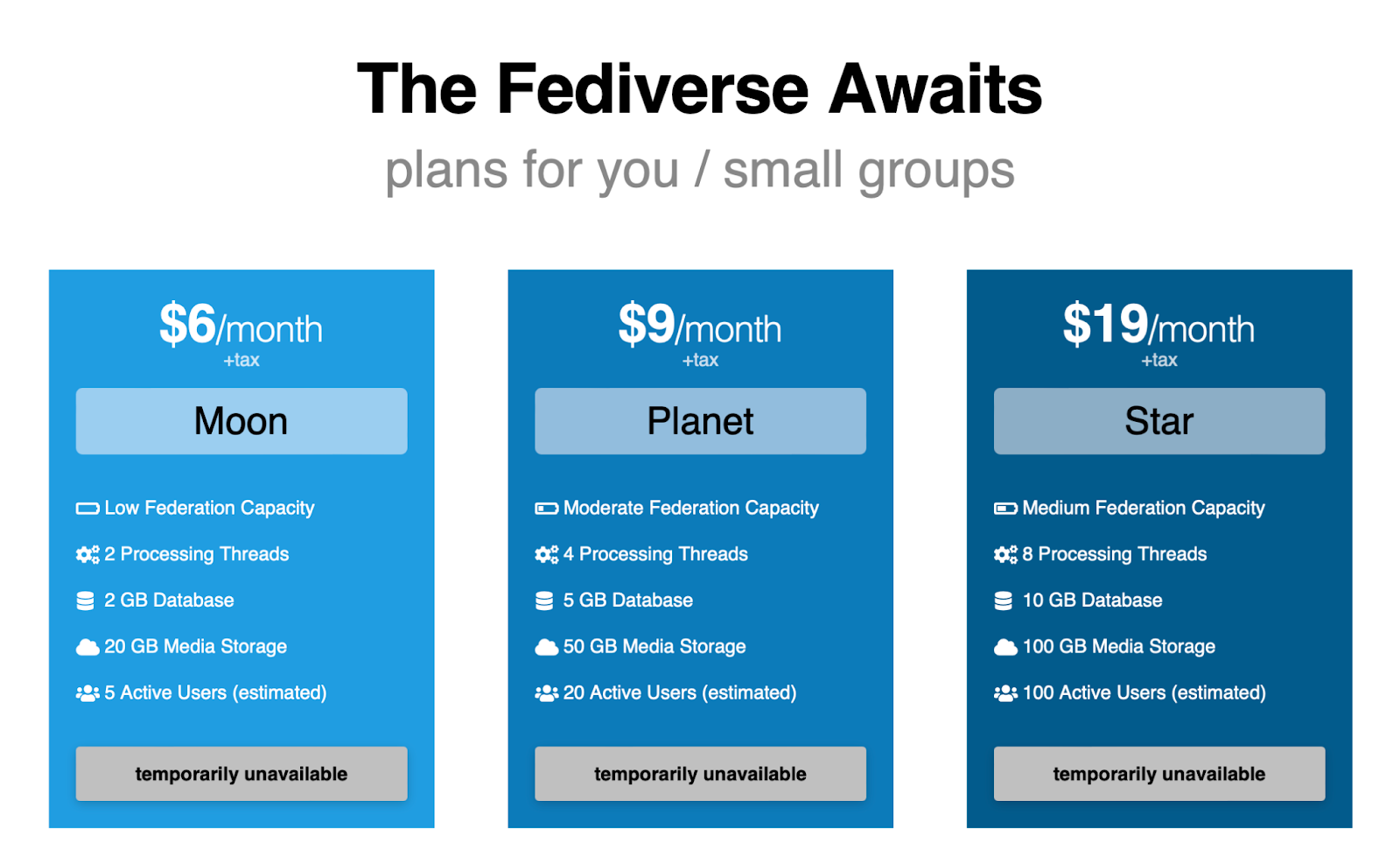
Thanks to the managed hosting service, I had my newly purchased domain pointing to an IP address and in a few clicks, it magically turned into a brand-new server on the Fediverse. I lasted a day as a single-user instance before opening it to other members. As such, I became what’s known as an Admin, or server/instance owner. Fascinatingly, once you find yourself in the position of running a server on the Fediverse, you are instantly ordained an autocratic ruler of your own domain. You set the rules. You enforce them, even if arbitrarily or capriciously. You basically become the Elon of your own Twitter. You can even hand out blue checks willy-nilly, because you get to control the custom emoji on your server. Weirdly enough, prominent Twitter users started to apply to join my Mastodon instance almost immediately.
It’s been a learning experience. Here are some FAQs and initial thoughts based on my first couple of weeks as an Admin.
Who Built The Fediverse, And For Whom?
Trans, queer, neurodivergent, disabled, and other kinds of marginalized folk who exiled themselves from Twitter during the Trump years not only helped design the protocols and specifications (e.g., ActivityPub is part of what makes the magic work) but also promulgated the distinct culture of care that animates the etiquette and discourse of the Mastodon environment, deliberately trying to make a better version of social media, all while espousing the principles of free and open source software which intrinsically resists overt commercialization.
However, the Mastodon model has not evolved into true democratic governance, and as a result tensions have simmered between its communities and the Benevolent Dictator For Life (BDFL), Eugen Rochko (@Gargron) who maintains executive control over the Mastodon project through his nonprofit organization in Germany, occasionally infuriating people with the power he wields over the project.
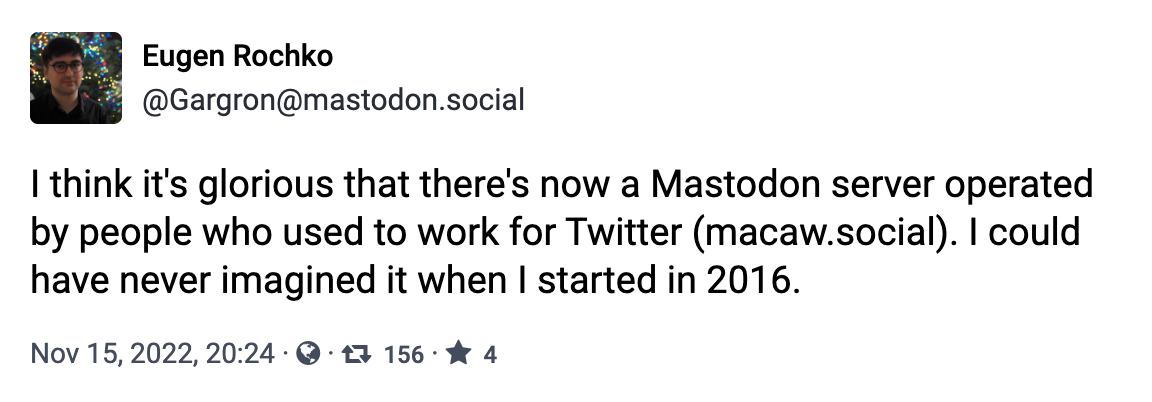
Some of the features that these communities persuaded Rochko to adopt include the distinctive CW feature. People are encouraged to set ContentWarnings (CW) over a broad range of trauma-related topics. Another way I like to think about this feature is as Consent Widgets, where instead of trying to trigger people on their timelines and getting rewarded for that, you erect some friction akin to a subject line, creating a layer of inferred consent in the timeline experience. A Consent Widget asks, would you consent to opening up my post about an intense topic? This fosters something different from the barrage of neurotic stimulations in the game of performative manipulation on Twitter and other social platforms. For folks trying to manage their mental health or avoid triggering topics, the Consent Widget feature expresses a kindness that you don’t find elsewhere.
Unfortunately, this well-meaning feature has also been used abusively against people. Features designed with the best intentions shall be weaponized. Likewise, some newcomers resent being relentlessly policed about their use of the CW feature by stalwarts, causing tension in the timelines. Mastodon offers customizable feed filters as part of the way it demands your labors of self-care and curation to confront dissent and diversity as baseline to the federated experience. This new work feels part of the price of decentralizing ourselves by running on free software managed by volunteers or nonprofit workers as our dependance on a centralized commercial social media platform made safe for advertising disintegrates.
The ableist style typical on Twitter, where accessibility concerns are routinely ignored, gets called out on Mastodon where, by contrast, people are expected to write image descriptions for ALT text so that screen readers work properly for the unsighted. Similarly, because #HashTagging is an essential practice on the Fediverse, people can be observed reminding each other to employ mixed case when typing out multi-word hashtags so screen readers can pronounce them.
Consider how this supportive community was suddenly invaded by the influx of people fleeing Elon Musk’s capture and destruction of Twitter. They’ve been stressed by anxiety that birdsite people just don’t get it. The work to create the anti-twitter could be at risk by migrators like me who, instinctively or out of grief, reimpose and reinforce bad Twitter habits rather than taking the fresh start in a new home as the cue to establish new healthier habits.
However, the Fediverse is not automatically a paradise of inclusion and civility, despite its radically different technical structure and business model. On the contrary, the darkest, worst behaviors on the internet are also thriving out here in the hinterlands. Part of becoming your own server administrator is confronting the urgent need to block and defederate your community from the absolute worst-of-the-worst. This adds to the tragedy that vulnerable folks are pushed out into feral social media spaces, rather than feeling safe and included on a centrally administered platform.
A more mainstream network-of-networks within the Fediverse could be emerging, where consensus forms on a so-called fediblock list by which admins circulate lists of systemic offenders and cesspit instances. Part of surviving behind a Mastodon account still involves learning how to deploy a fediblock list, either behind a trusted admin, or on your own by managing your own settings. Either way, one must build out protections for being in the wild. Brainstorms are already circulating from former Twitter engineers proposing an entirely new model of content moderation where instances could outsource and delegate their reports to a professional third-party service provider. Presumably, members would generously fund their own instance, which in turn funds a living wage and commensurate labor conditions for federated content moderation teams.
These new ideas are necessary because it’s been saddening to witness, in particular, women of color and other groups endure harassment without adequate social infrastructures and community codes of practice already developed. Despite all of the efforts and features described above, the default settings still have a way of preferencing and privileging whiteness. There is a feeling of starting from scratch out here, though. Learning from our mistakes in real time during this experiment, we might build something fundamentally better.
In these ways, folks are out here in the digital wilderness seeking refuge and a better world. Elon Musk “sub-tooted” the Mastodon community when he referred to “judgy hall monitor” types while exalting our departures, perhaps signaling his intent as admin to move his instance toward brutality rather than mutuality.
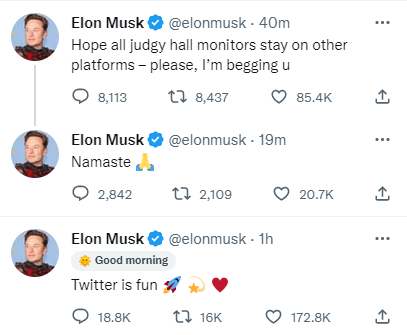
How Is Mastodon An Anti-Twitter?
Typically, Twitter migrators go through a process of complaining about Mastodon to praising its virtues in just a few days. Here are a few common aspects of this experience:
Decentralizing Means Picking a Server
Picking a server (or instance) is hard. Despite what you may hear, it’s consequential. The official Mastodon nonprofit page routes people toward Covenant servers which offer certain important protections for users. There aren’t enough good ones to choose from at the moment. An unofficial directory at instances.social helps you find servers by size and content policy. Moving to another server is possible but not that easy, especially for beginners. The big servers are probably too crowded and there needs to be a period of decentralizing off of them after the initial influxes towards lateral migration that will form the new neighborhoods of the Fediverse. Curating one's own feed becomes constant work of selection and curiosity. Finding the right neighborhood in the Fediverse is not so different than it is in real life.

Non-Algorithmic Onboarding Is Hard
You immediately appreciate how much algorithmic growth-hacking goes into onboarding new users into Twitter, so that a timeline instantly appears to engage the “cold-start” user. On Mastodon, there are no growth hackers or recommendation algorithms, so you are asked to cultivate your own timeline by finding folks to follow. Until you assemble a worthy set of people (and tags) to follow, the experience feels disconnected and disorienting. But once you make some progress tending to your garden, your feed lights up and delivers a satisfying, very-Twitter-like experience, especially because so many of Twitter’s most wonderful people have also joined Mastodon.
Stranger Things Like Multiple Timelines In The Parallel Universe
Unlike the centralized concept of Twitter’s timeline, Mastodon has three distinct reverse-chronological timelines to explore:
- Your Home timeline includes accounts and hashtags you follow
- Your Local timeline includes posts from others on your instance
- Your Federated timeline includes posts from what is getting boosted in the network neighborhood
On small instances, all three timelines should feel manageable and useful, while on the big instances they can get chaotic and overwhelming. If your local and federated feeds aren’t worth scrolling through then that could be a signal to find a trustworthy instance more in line with your own interests. Give it time, though. There is no rush, and it could take awhile for your ideal new neighborhood to develop.
No QTs, No Dunks, No Call-and-Response
One habituation of Twitter is the quote tweet maneuver, but Mastodon offers no such obvious affordance. This is said to be intended to frustrate the instinct to dunk. Interestingly, a former Twitter engineer has posted to Mastodon suggesting that the Quote Tweet feature was not measured to have caused an increase in abuse. Furthermore, Eugen Rochko has hinted at being open to introducing the feature in a future version, much to the dismay of certain marginalized communities who specifically appreciate the dunk-free zone. Other voices lament the omission of the quote tweet affordance as elemental to the playful call-and-response style of Black Twitter. The alternative convention that could be called a Self-Boosted Quote Reply, hasn’t been observed as a species in the wild.
Full Self-Driving Verification
Mastodon lets you self-verify from another website you control. It’s a bit nerdy, but this approach maintains the essence of decentralization while solving the problem of verifying a profile’s true identity. A unique feature of the Mastodon profile is the way it offers a 2x4 table of meta-data that many people fill with links to other websites. If you control a website enough to be able to write an HTML link back to your Mastodon account with the rel=me attribute, then that website appears verified with a green check on your Mastodon profile. This allows anyone with their own domain to self-verify, assuming the referenced domain serves as a validating reference (i.e., it’s verifiable who owns it).
The Revolution Will Not Be Monetized
The Mastodon software does not support advertising, the injection of adtech, or analytics. Many instances in the community outright ban advertising. Even parody servers of brands risk being blocked for spam. Instead, the Mastodon project is largely supported by grants and donations on Patreon or OpenCollective, while individual instances not affiliated with the official project are self-supported by donations and the efforts of volunteers who help develop the software and admin/mod servers.
Freedom Of Movement On Mastodon
Moving servers is an essential feature of the Fediverse but there are some confusing nuances. You have to export your follow list and re-import them to your new home but your followers will automatically follow you. While you can export your data from an old server, you cannot bring your old posts along to the new one. They stay behind but if you ever want to return and reactivate your old account, it’s there waiting for you, along with your old posts.
The Direct Message Weirdness
Mastodon’s post settings also take time to figure out, because a post can be set to go Public into the feeds of anyone, or set to Unlisted which keeps it within the instance realm, or scoped to Followers only, which limits reach for locked accounts, and then Direct Message for discreet messages and breaking off the timeline mentions.
These Discreet Messages, as I wish they were called, behave very differently from DMs on other platforms and can catch you in awkward situations. For instance, if you mention someone, they are joined into the conversation! But this clues us into how they incentivize a less-performative, attention-merchandising social media modality, where arguing in public and sliding into DMs to talk smack is a bad habit to break.
DMs on Mastodon also appear in the timeline. This potentially signals their unique purpose. When it’s time to pull mentions off the reply thread, you shift to “Discreet,” where now the branch of the discussion that does not offer value to other people’s timelines is courteously closed. The pattern of being conscious of how you impact other people’s experiences is embedded in the UI.
That said, there is no UI for admins to read your DMs on Mastodon. They are transmitted and stored, un-encrypted, in the database. An admin could be obliged to respond to law enforcement as necessary, or may choose to snoop. You’re reminded in the UI that these are not secure comms.
Adding true encryption to Mastodon seems tricky. If you think Mastodon is difficult to use without zero-knowledge end-to-end encryption, just wait until it’s added and folks have to learn about public and private keys. If you’ve used ProtonMail, you may have a better sense of how difficult it can be to deliver this level of security in a browser, let alone across various open source apps. How does one get around the problem that Admins can reset your password? If we consider Signal, the need for us to expose our phone number is the big tradeoff that makes that platform so easy to use. I encourage newcomers to try to get over this concern for now (yeah, a privacy zealot is telling you to get over this hurdle). You can always choose not to use “Discreet Messaging,” and it doesn’t need to be an obstacle to your adoption of Mastodon generally.
Most people seem to hate Mastodon’s DMs and I am weird for thinking they could be good if we imagined them differently. A former Twitter developer who has drafted an initial charter concept for the Fediverse, expressed views on this topic and strong disagreement with how Rochko’s idiosyncratic DMs that don’t meet the usual expectations. It seems there is a strong preference for the conventional understanding of this feature, instead of a new adaptation that prefers moderating attention harvesting over pure privacy. Apparently, the Signal organization has been invited to participate in the process of encrypting DMs on Twitter.
What’s It Like To Admin An Instance?
Managed Or DIY
As a “Managed host,” I don’t worry about the infrastructure, I worry about the community. If you’re comfortable on the command line, you could certainly explore going ‘hardcore’ by setting up your own infrastructure on ‘bare metal,’ but then you get to worry about both.
An Admins’ main community focus is on content moderation tasks, which includes screening new member applications, responding to reports from your members and taking actions like limiting, deleting, or blocking users or entire instances (servers by domain). This is called de-federating, and it’s supposed to be used as a last resort, but I am finding it wholly justifiable to pre-emptively defederate some truly abhorrent servers. It is important to prevent illegal content from ending up on my server. Since launching, I have fielded less than a dozen reports. One of those was a user reporting me, so I myself have already gone through the looking glass of reporting Elon Musk’s account for abuse on Twitter.
Free As In Freedom But Not As In Beer
Admins are also responsible for monitoring server load and upgrading as needed. I find myself frequently checking my Sidekiq dashboard which shows real time activity. When your server can’t keep up with the load, a backlog starts to build up. The more people you support, the more processing threads and storage you’re going to gobble up. There are costs involved — luckily my members have already generously funded current capacity for 1 year through a PayPal link in my bio. I’m currently serving about 300 active members on a service tier costing $49 a month (comes to $2 a year per person).
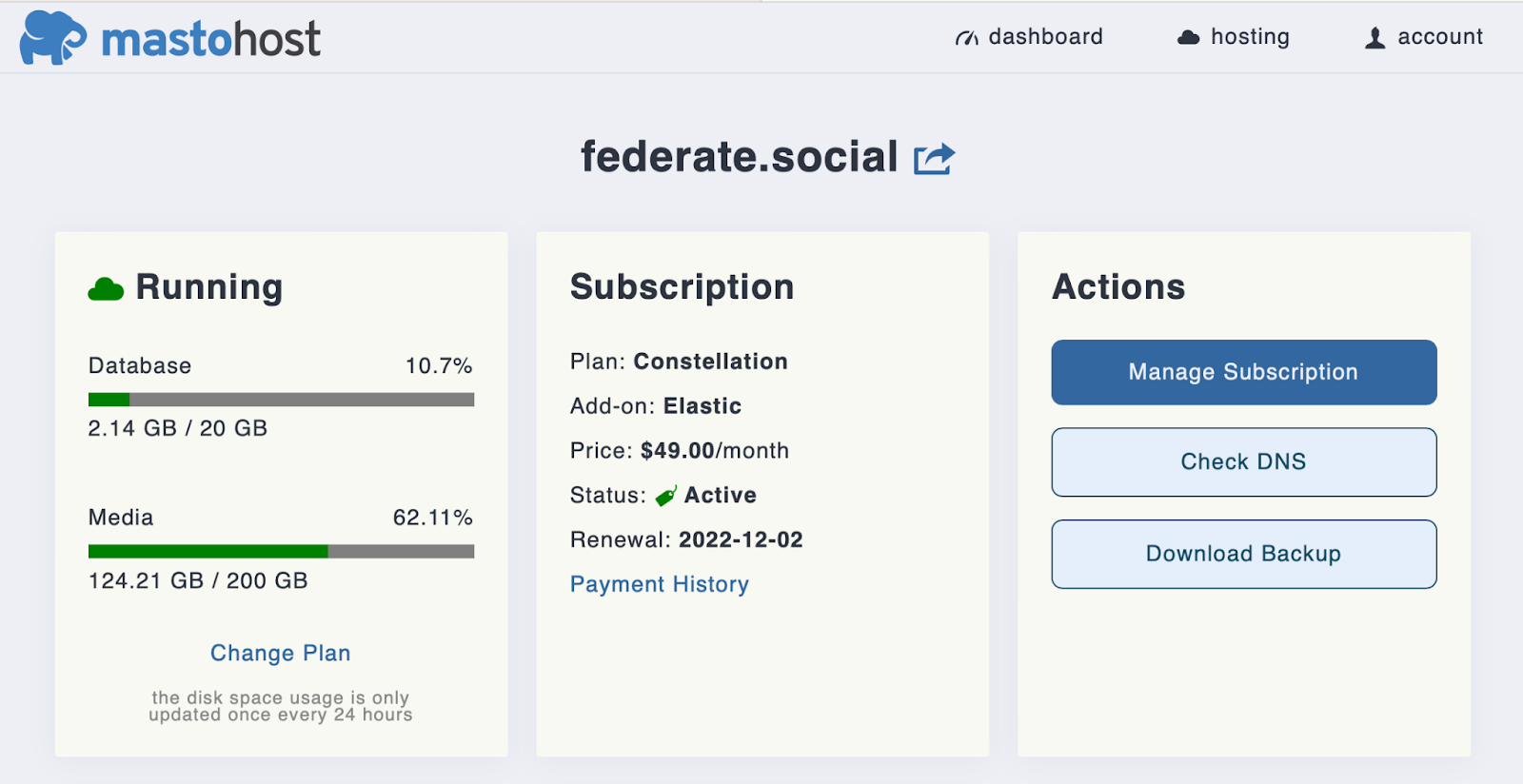
Get Real
I’ll need to formalize certain aspects of the instance after I reach a member base milestone, including appointing a co-admin and moderator team; getting set up with a fiscal sponsor who would want to sponsor us at OpenCollective, or; setting up my own LLC, or finding partners to establish a co-op or non-profit. My server is in France, so Europe’s General Data Protection Regulation (GDPR) applies; that means I may need an EU-based person on the team. I registered with the US Copyright Office for DMCA, because now I may need to respond to a takedown request. Formalizing the above with governance would help us become a Covenant server and get listed in the main directory. That would mean the instance might be recommended to new registrants from the Mastodon project itself.
Should You Set Up Your Own Server?
There is an acute demand for new, well-moderated spaces to welcome new members to be on-boarded, as well as for relieving over-crowded “official” instances. The testimonials of Black users and other people of color who are having horrible experiences on the big instances are shameful and unsurprising, given that content moderation does not scale that well anywhere without significant resources. But in my experience, smaller servers should have the tools and wherewithal to build safer communities because they operate at a smaller scale and yet interface with the larger network neighborhood. This involves people willing to serve on the frontlines of a decentralized information war to protect their own communities. Mistakes will be prevalent. Resolute patience is compulsory.
Hopefully, someone will clone the Masto.host UX for managed services so that infrastructure responsibility is outsourced and simplified into a web interface. If hosted in the US, the privacy protections will be weaker, for now, but the legal status might be somewhat clarified. When that happens, I hope a thousand new servers bloom. It’s also entirely possible that the challenges of running your own vanity social network pile up after a wistful honeymoon phase. Only time will tell if it’s a fool’s errand, best left to professionals and a sustainable business model, or an important moment of punctuated equilibrium..
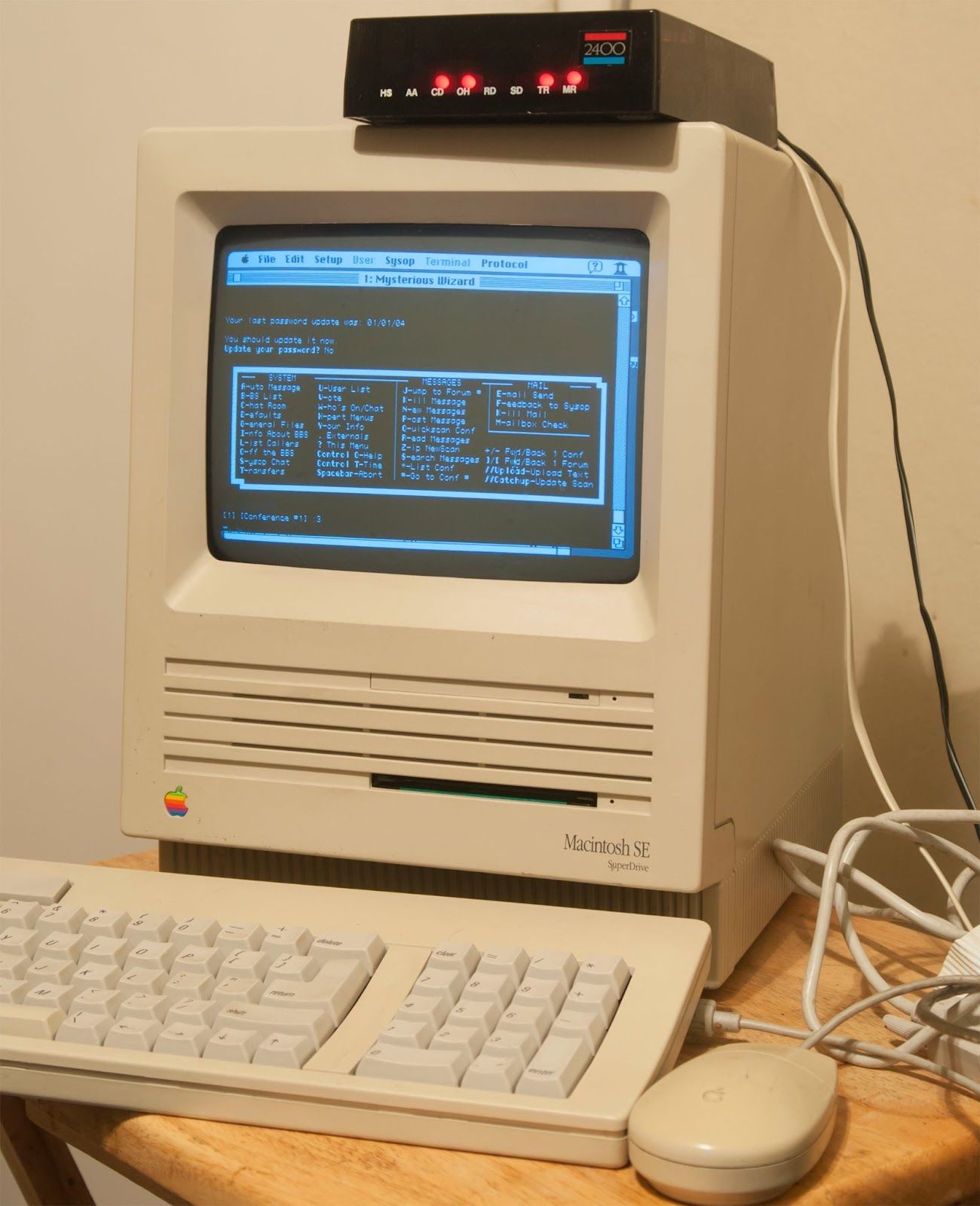
Closing Thoughts
As a genXer myself, I have vivid memories of various Revenge-of-the-Nerds moments in the history of technology, where a peer-to-peer innovation shakes up the status quo. The first such occasion came in high school when I ran a BBS (bulletin board system) over dial-up modems (2400 baud, baby) on local telephone lines using free shareware software called Hermes. Weirdly enough, back then, people dialed into each other’s computers and posted on message boards. There were GIFs. Then in college, Napster (and later LimeWire, BitTorrent, etc.) upended the music industry and triggered the pivot to digital subscriptions. It showed that people would tolerate an unintuitive, nerdy UX in order to get what they wanted, how they wanted it. In many ways, setting up a Mastodon server is a re-kindling of this spirit of re-working our digital life around a peer-to-peer exchange instead of a centralized service. That moment when my Mastodon feed sparked to life somehow automatically as friendly familiar faces appeared echoes that uncanny moment when I typed a favorite album into Napster. For skeptics of Mastodon, I wonder if this would suggest that this weird software is not itself the future of social media, but rather portends disruption. It points to an epic power struggle over who controls the means of social media production and distribution, a struggle that may well be with us long after Elon and his ilk have decamped for Mars, or beyond.
#FediTips
Learn the syntax for sharing your Mastodon address as a clickable link:
Format: @handle@instance.tld
Example: @profcarroll@federate.social
URL Format: https://instance[.]tld/@handle
Example: https://federate.social/@profcarroll
Mastodon Instance URL shortcuts
Three are buttons and menus for these pages but if you want to skip direct or bookmark a feature, you can add an instance domain name in front of / to complete these shortcut paths:
/explore See any* server’s trending posts, topics, articles
/directory See any server’s member directory
/public See any sever’s federated timeline
/public/local See any server’s local timeline
/about See any server’s information and rules
/privacy-policy See any server’s privacy policy
/settings/profile Shortcut to edit your profile page
/settings/import Shortcut to import CSV lists into your account
/settings/export Shortcut to export data from your account
/settings/aliases Shortcut to prepare moving to new instance
/settings/migration Shortcut to leave an old instance
(*Note: not all instances open these links to the public, applies to Mastodon 4 and up)
Find Your Twitter Friends on Mastodon
https://movetodon.org — Easiest to use because you login to both your Twitter and Mastodon
https://fedifinder.glitch.me — Scan linked Twitter for CSV file to upload into Mastodon
https://debirdify.pruvisto.org — Full-featured CSV generator for Twitter
Mastodon Mobile Apps
Bookmarking your instance to an icon on your device’s home screen works surprisingly well.
iOS: The official Mastodon app limits you to your Home timeline only which is sort of like training wheels for Mastodon.
MetaText: more fully featured, free and open source
Toot!: delightful paid app that lets you lurk and engage across instances without being a member
Mammoth: currently in TestFlight beta and seems very promising
Android: Folks seem to recommend Tusky
Authors
